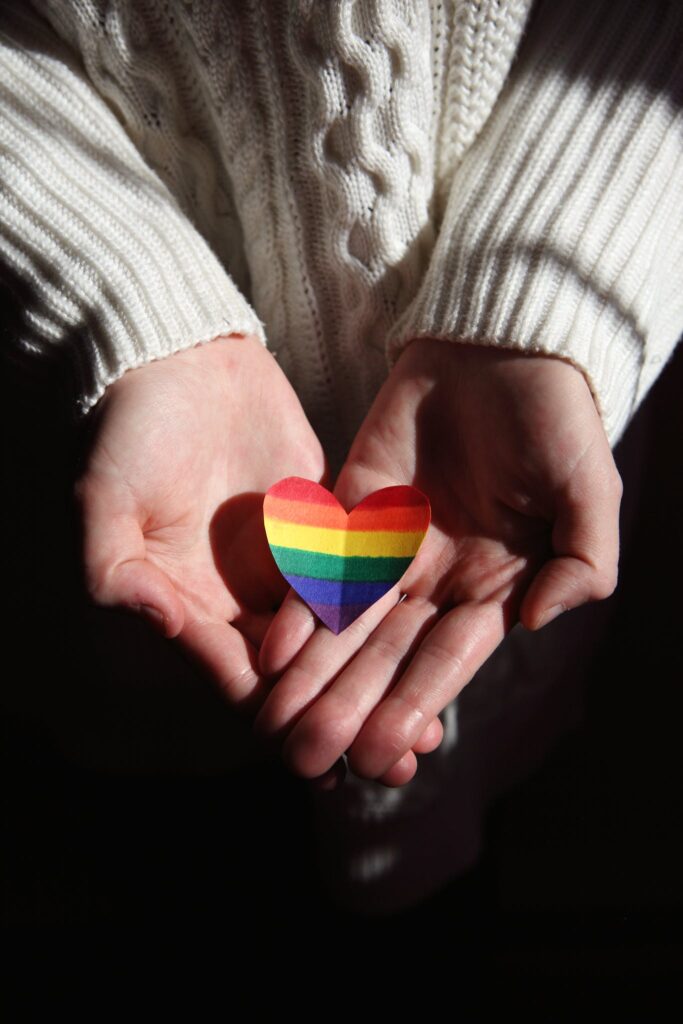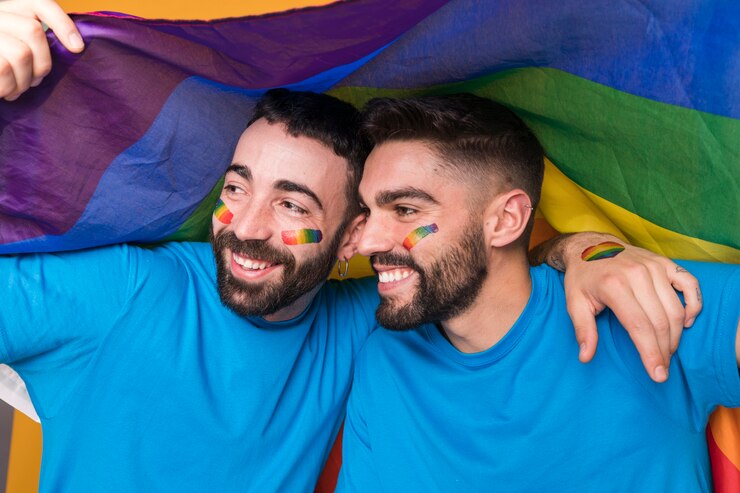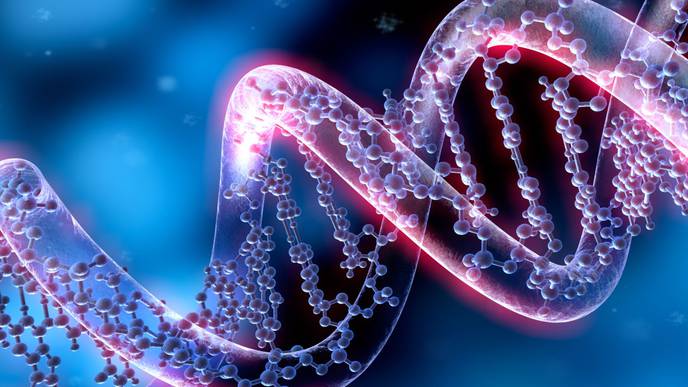Homosex: A Guide to Sexual Orientation and Identity

Understanding Sexual Orientation and Identity
Sexual orientation and identity are complex aspects of human diversity that have garnered significant attention and understanding in recent years. When discussing sexual orientation, it is important to recognize that it refers to an individual’s enduring emotional, romantic, and/or sexual attraction to others. It is an integral part of a person’s identity, and research suggests that sexual orientation is not a choice but rather an innate and deeply fundamental aspect of who we are.
There is a wide spectrum of sexual orientations, including but not limited to heterosexual (attraction to the opposite gender), homosexual (attraction to the same gender), bisexual (attraction to both the same and opposite genders), and asexual (lack of sexual attraction). It is crucial to acknowledge that individuals may identify with a range of labels or choose not to label their sexual orientation at all. It is important to respect and support people’s self-identified orientations, as they possess the autonomy to define their own identities.
Various factors contribute to the development of sexual orientation, including biological, genetic, hormonal, and environmental influences. Research suggests that there may be genetic and hormonal components at play, but the exact mechanisms are not fully understood. It is essential to approach discussions on sexual orientation with sensitivity, embracing a deep respect for the inherent diversity of human experiences. By nurturing understanding, empathy, and acceptance, we can create a world that celebrates the richness of sexual orientation and fosters inclusivity for all individuals.
Exploring the Spectrum of Human Sexuality
The spectrum of human sexuality encompasses a wide range of orientations and identities that go beyond the traditional binary understanding of male and female. It is important to recognize that sexual orientation and identity are not fixed or determined solely by biological factors, but are complex and multifaceted. Research has shown that sexual orientation is influenced by a combination of genetic, hormonal, and environmental factors, highlighting the intricate interplay between biology and social factors.
In recent years, there has been a growing acceptance and understanding of diverse sexual orientations and identities. The LGBTQ+ community, which stands for lesbian, gay, bisexual, transgender, and queer/questioning, is a testament to the rich diversity within human sexualities. It is crucial to acknowledge and respect this diversity, as it promotes inclusivity and fosters a sense of belonging for individuals whose sexual orientations and identities fall outside the societal norms. By recognizing and embracing this spectrum of human sexuality, we can create a society that celebrates and values the uniqueness of each individual.
The Influence of Biology on Sexual Orientation
Researchers have long sought to understand the influence of biology on sexual orientation, recognizing that it is a complex interplay of multiple factors. While there is no singular “gay gene” that determines one’s sexual orientation, studies have shown that there may be a genetic component to sexual orientation. Research conducted by the National Institutes of Health (NIH) in 2019 found that there are certain genetic variants associated with same-sex sexual behavior, suggesting a role of genetics in sexual orientation.
In addition to genetics, hormonal influences during prenatal development have also been suggested to play a role in sexual orientation. One hypothesis posits that exposure to certain levels of sex hormones in utero may affect the development of sexual orientation later in life. Studies, such as the research conducted by the University of California, Berkeley, have shown higher levels of androgen exposure in women with same-sex attraction. However, it is important to note that these hormonal influences are not deterministic and do not solely account for sexual orientation. The interplay between biology and other factors, such as social and environmental influences, remains a topic of ongoing research and debate.
Social Factors Shaping Sexual Identity
The development of sexual identity is influenced by a variety of social factors, which play a crucial role in shaping an individual’s understanding of and comfort with their own sexual orientation. One such factor is societal norms and expectations surrounding sexual behavior and attraction. From a young age, individuals are exposed to societal messages about what is considered “normal” or “acceptable” when it comes to sexual orientation. These messages can come from family, religion, the media, and other social institutions, and can have a powerful impact on an individual’s sense of self and their willingness to embrace their true sexual identity.
Additionally, the influence of peers and social networks should not be underestimated. Adolescence, in particular, is a time when individuals are exploring their own identities and seeking validation from their peers. This period of self-discovery can be especially challenging for those who identify as LGBTQ+ and may face discrimination or rejection from their social circles. On the other hand, having a supportive network of friends and allies can be a tremendous source of strength and resilience for individuals as they navigate their own sexual identity. It is important to recognize the significant role that social factors can play in shaping sexual identity and to foster an inclusive and accepting society that celebrates the diversity of human sexuality.
Recognizing the Diversity Within LGBTQ+ Community

Recognizing the diversity within the LGBTQ+ community is essential for fostering understanding, acceptance, and support for all individuals. Sexual orientation and gender identity exist on a vast spectrum, encompassing a variety of experiences and perspectives. It is important to acknowledge that no single narrative can adequately represent the entire LGBTQ+ community, as each person’s journey is unique.
Many individuals within the LGBTQ+ community identify with different labels, such as lesbian, gay, bisexual, transgender, queer, or questioning. These labels provide a sense of identity and allow individuals to connect with others who share similar experiences. However, it is crucial to remember that not everyone fits neatly into these categories, and some may prefer alternative terms or reject labels altogether.
Moreover, gender identity is distinct from sexual orientation, and it is important to understand and respect the differences. While sexual orientation refers to an individual’s emotional, romantic, or sexual attraction to others, gender identity relates to one’s deeply felt sense of being male, female, or another gender entirely. Individuals may identify as transgender, non-binary, genderqueer, or gender non-conforming, to name just a few possibilities.
To truly recognize and appreciate the diversity within the LGBTQ+ community, it is vital to approach each individual with an open mind and respect their self-identified labels and experiences. By embracing the unique perspectives and identities within this diverse community, we can create a more inclusive and accepting society for all.
Common Misconceptions about Sexual Orientation
Misconceptions about sexual orientation can perpetuate stereotypes and contribute to the stigmatization and discrimination faced by individuals who identify as LGBTQ+. It is crucial to address and debunk these misconceptions in order to promote understanding and acceptance.
One common misconception is that sexual orientation is a choice or can be influenced by external factors. However, a wealth of scientific research supports the understanding that sexual orientation is a fundamental aspect of a person’s identity and is not a choice. Numerous studies have shown that sexual orientation is deeply rooted in biological factors, including genetic, hormonal, and developmental influences. For instance, research conducted by Dr. Brian Mustanski at Northwestern University found that identical twin brothers, who share identical genes, are more likely to have the same sexual orientation compared to fraternal twins, indicating a strong genetic influence. Additionally, a study published in the journal PNAS revealed that certain hormone exposure during fetal development can play a role in shaping sexual orientation. These findings highlight the complex interplay of biology in determining sexual orientation and emphasize the importance of recognizing it as an inherent part of an individual’s being.
The Process of Coming Out and Its Challenges
Coming out, or the process of disclosing one’s sexual orientation or gender identity, can be a deeply personal and complex journey for many individuals within the LGBTQ+ community. It is a process that often involves self-reflection, acceptance, and ultimately, sharing this personal information with others. However, it is important to recognize that coming out can be a challenging experience, encompassing both positive and negative aspects.
One of the challenges that individuals may face during the coming out process is fear of rejection or discrimination. LGBTQ+ individuals may worry about how their friends, family members, or colleagues will react to their disclosure. This fear stems from societal stigma and lack of acceptance, which can lead to strained relationships or even rejection from loved ones. According to a survey conducted by the Trevor Project, over 40% of LGBTQ+ youth reported experiencing rejection from their families after coming out. This underscores the need for increased support and awareness to create an environment of acceptance and understanding for those who are coming out.
Supportive Resources for LGBTQ+ Individuals
Supportive resources play a crucial role in providing assistance and guidance to LGBTQ+ individuals, helping them navigate through various challenges and complexities they may face in society. These resources offer a safe and inclusive space where individuals can seek information, support, and community.
One valuable resource is LGBTQ+ support organizations, such as The Trevor Project and GLAAD. These organizations offer helplines, online chat services, and resources specifically tailored to address the unique needs of LGBTQ+ individuals. The Trevor Project, for instance, offers 24/7 crisis intervention services for LGBTQ+ youth, including suicide prevention, counseling, and support. GLAAD focuses on media advocacy and education, working to promote accurate and fair portrayals of LGBTQ+ individuals in media and entertainment.
Additionally, LGBTQ+ community centers provide a range of services and programs, including support groups, counseling, and educational workshops. These centers serve as gathering spaces for LGBTQ+ individuals and offer a sense of belonging and acceptance. They often also host events and activities to promote social connections and community building.
Online forums and social media platforms can also be invaluable resources, connecting LGBTQ+ individuals from all walks of life. These platforms enable individuals to share experiences, find support, and access information. Reddit’s LGBTQ+ communities, for example, provide a platform for individuals to ask questions, seek advice, and connect with others who may have similar experiences.
Supportive resources not only provide information and assistance but also play a vital role in fostering a sense of belonging, understanding, and empowerment for LGBTQ+ individuals. By utilizing these resources, individuals can find the support they need to navigate their journey and lead fulfilling and authentic lives.
Navigating Relationships and Intimacy in the LGBTQ+ Community
Navigating Relationships and Intimacy in the LGBTQ+ Community can present unique challenges and experiences that require understanding and support. The journey of building and maintaining relationships, both romantic and platonic, can be influenced by various factors, including sexual orientation and gender identity. It is crucial to create a safe and inclusive environment where individuals can freely express themselves and foster healthy connections.
Understanding the diverse nature of relationships within the LGBTQ+ community is fundamental. Individuals may identify as lesbian, gay, bisexual, transgender, queer, or other identities, each with their own specific dynamics and needs. This includes recognizing that relationships can consist of same-sex or different-sex partnerships, as well as those that transcend traditional binary understandings of gender. It is essential to foster an atmosphere of acceptance and respect, highlighting the importance of communication, consent, and mutual understanding to nurture strong and fulfilling connections.
Exploring Gender Identity and Expression
Gender identity is a deeply personal aspect of an individual’s sense of self. It refers to how a person perceives and experiences their own gender, which may or may not align with the sex assigned to them at birth. In society, we often categorize individuals as either male or female based on their biological sex, but this binary understanding fails to capture the complexity of gender.
It is important to recognize that gender exists on a spectrum, with a wide range of identities beyond just male or female. Some individuals identify as transgender, meaning their gender identity does not match the sex they were assigned at birth. Others may identify as non-binary, genderqueer, or genderfluid, among other terms. Understanding and respecting these diverse gender identities is crucial for creating an inclusive and supportive society. It is essential to use individuals’ preferred pronouns and respect their self-identified gender, as this helps to validate and affirm their identity. By recognizing and embracing the breadth and fluidity of gender identity, we can foster a more accepting and inclusive environment for all.
The Intersectionality of Race, Ethnicity, and Sexual Orientation
When discussing sexual orientation, it is crucial to recognize and appreciate the intersectionality of race, ethnicity, and sexual orientation. Each aspect of a person’s identity contributes to their unique experiences and challenges within the LGBTQ+ community. The intersectionality of these three factors not only shapes individual experiences but also influences societal perceptions and opportunities.
Research has shown that individuals who belong to racial and ethnic minority groups often face additional barriers and discrimination related to their sexual orientation. For example, studies have found that LGBTQ+ individuals from racial and ethnic minority backgrounds are more likely to experience higher rates of violence, substance abuse, and mental health issues compared to their white counterparts. This can be attributed to the compounding effects of racism, homophobia, and other forms of discrimination.
Understanding and addressing the intersectionality of race, ethnicity, and sexual orientation is crucial for promoting inclusivity and equality within the LGBTQ+ community. By acknowledging the unique challenges faced by individuals at these intersections, we can work towards creating a more supportive and inclusive society for all. It is imperative to recognize the diversity within the community and amplify the experiences and voices of individuals from all racial, ethnic, and sexual orientation backgrounds.
Religious and Cultural Perspectives on Homosexuality
Religious and cultural perspectives on homosexuality vary greatly around the world. Different religious traditions and cultural norms shape individuals’ understanding and attitudes toward same-sex relationships and identities. While some religions and cultures perceive homosexuality as morally wrong or deviant, others embrace and affirm diverse sexual orientations.
In many conservative religious communities, homosexuality is often viewed as incompatible with religious teachings. Certain passages from religious texts or traditional beliefs are interpreted to condemn same-sex relationships, leading to stigmatization and discrimination against LGBTQ+ individuals. These perspectives can have significant impacts on the social and psychological well-being of sexual minorities within these communities.
However, it is essential to recognize that not all religious and cultural perspectives hold negative views on homosexuality. Many progressive religious groups and spiritual traditions have embraced more inclusive and accepting attitudes toward LGBTQ+ individuals. These communities often emphasize the importance of love, compassion, and equality as core principles. LGBTQ+ individuals who are part of such groups can find acceptance and support in navigating the intersections of their sexual orientation and faith.
Understanding the diversity of religious and cultural perspectives on homosexuality is crucial for fostering dialogue and promoting tolerance and acceptance within societies. By recognizing the complexity of these perspectives and seeking common ground, it becomes possible to create a more inclusive and compassionate environment for LGBTQ+ individuals.
Legal Rights and Protections for LGBTQ+ Individuals
Legal rights and protections for LGBTQ+ individuals have evolved significantly over the years, reflecting a growing recognition of the importance of equality and inclusivity. While progress has been made in many parts of the world, there are still variations in legal frameworks and societal acceptance. It is crucial to understand the different laws and protections in place to ensure that LGBTQ+ individuals are aware of their rights and can navigate the complexities of their legal status.
In many countries, discrimination based on sexual orientation or gender identity is prohibited by law. This includes protections in areas such as employment, housing, healthcare, and education. For instance, in the United States, the Civil Rights Act of 1964 prohibits discrimination based on sex, which has been interpreted by courts to include protection for LGBTQ+ individuals. Similarly, the Employment Equality Acts in Ireland provide legal protection against discrimination in employment on the grounds of sexual orientation or gender identity.
Moreover, some countries have gone beyond anti-discrimination laws and have legalized same-sex marriage, recognizing the right of LGBTQ+ couples to have their relationships legally recognized and protected. This not only grants legal benefits and responsibilities, such as inheritance rights and access to healthcare, but also serves as a powerful symbol of equality and acceptance.
However, while legal protections are vital, it is important to acknowledge that societal attitudes and cultural norms play a significant role in shaping the experiences of LGBTQ+ individuals. Discrimination and social stigma are still prevalent in many parts of the world, making it essential to continue advocating for equal rights and fostering inclusive environments for all. Additionally, understanding the intersectionality of LGBTQ+ identities with other aspects such as race, ethnicity, and religion is crucial in promoting comprehensive and equitable legal protections.
By providing accurate information and raising awareness about legal rights and protections, we can contribute to creating a more inclusive and accepting society for LGBTQ+ individuals. This necessitates ensuring that laws are in place to protect against discrimination, while also addressing the underlying social factors that contribute to inequality. Only through a collective effort can we advance the rights of LGBTQ+ individuals and promote acceptance and inclusion for all sexual orientations.
Mental Health and Well-being in the LGBTQ+ Community
When it comes to mental health and well-being, the LGBTQ+ community often faces unique challenges and struggles. Research consistently shows that individuals who identify as LGBTQ+ are at a higher risk for mental health disorders, such as depression, anxiety, and substance abuse, compared to their heterosexual and cisgender counterparts. According to a national survey conducted by the National Alliance on Mental Illness, LGBTQ+ individuals are three times more likely to experience a mental health condition in their lifetime. Additionally, they may also face higher rates of suicidal ideation and attempts.
There are several factors that contribute to these disparities in mental health outcomes. One important factor is the experience of minority stress, which refers to the chronic social stressors faced by individuals who belong to stigmatized groups. LGBTQ+ individuals may experience discrimination, prejudice, and stigma in various aspects of their lives, including at school, work, and even within their families. These experiences can lead to feelings of isolation, shame, and low self-esteem, which can have a profound impact on their mental well-being. Furthermore, the lack of legal protections and societal acceptance can exacerbate these challenges, making it even more difficult for individuals to seek the support they need.
In order to address these mental health disparities, it is crucial for healthcare providers to create an inclusive and affirming environment for LGBTQ+ individuals. This includes having knowledgeable and culturally competent healthcare professionals who understand the unique health needs and challenges faced by this community. It is equally important to promote mental health awareness and education within the LGBTQ+ community, providing resources and support networks that can help individuals navigate the complexities of their identity and mental well-being. By working together to promote acceptance, inclusivity, and access to appropriate mental healthcare, we can support the mental health and well-being of all individuals, regardless of their sexual orientation or gender identity.
Promoting Acceptance and Inclusion for All Sexual Orientations
Creating a society that promotes acceptance and inclusion for all sexual orientations is a crucial step towards fostering equality and respect. It is imperative to recognize that sexual orientation is a fundamental aspect of human diversity, and no one should be discriminated against based on their attractions or identity. This includes individuals who identify as lesbian, gay, bisexual, pansexual, asexual, or any other sexual orientation. By embracing and celebrating the full spectrum of human sexuality, we can build a world where everyone feels valued and respected for who they are.
Promoting acceptance and inclusion involves challenging societal norms and biases that perpetuate discrimination and stigma towards individuals with different sexual orientations. It requires advocating for equal rights, protection, and opportunities for all, irrespective of their sexual orientation. This can be achieved through educational programs, policies, and legislation that promote understanding, respect, and tolerance. By creating safe spaces in schools, workplaces, and communities, we can empower individuals to express their sexual orientation without fear of judgment or discrimination. It is an ongoing process that requires continuous education, dialogue, and support to break down barriers and ensure that every individual feels valued, included, and free to live authentically.
What is sexual orientation?
Sexual orientation refers to a person’s enduring pattern of emotional, romantic, and sexual attractions to individuals of the same gender, different gender, or both genders.
Is sexual orientation a choice?
No, sexual orientation is not a choice. It is a natural and innate aspect of a person’s identity and cannot be changed or influenced by external factors.
Are people born with their sexual orientation?
Scientific evidence suggests that sexual orientation is influenced by a combination of genetic, hormonal, and environmental factors. While the exact causes are not yet fully understood, it is believed that people are born with their sexual orientation.
What is coming out?
Coming out is the process by which LGBTQ+ individuals disclose their sexual orientation or gender identity to others, often to friends, family, or colleagues. It is a personal and ongoing journey of self-acceptance and self-expression.
What challenges do individuals face when coming out?
Coming out can be a challenging experience for many individuals due to fear of rejection, discrimination, or loss of relationships. It can also involve navigating societal stereotypes and misconceptions about sexual orientation.
How can I support LGBTQ+ individuals?
You can support LGBTQ+ individuals by educating yourself about sexual orientation, being accepting and inclusive, using inclusive language, and advocating for equal rights and protections.
Are there resources available to support LGBTQ+ individuals?
Yes, there are various resources available to support LGBTQ+ individuals, including LGBTQ+ community centers, helplines, support groups, and online forums. Mental health professionals who specialize in LGBTQ+ issues can also provide assistance.
How does sexual orientation intersect with race and ethnicity?
The intersectionality of race, ethnicity, and sexual orientation recognizes that individuals may face unique challenges and experiences based on the combination of their racial or ethnic identity and sexual orientation.
What legal rights and protections are available for LGBTQ+ individuals?
Legal rights and protections for LGBTQ+ individuals vary across countries and jurisdictions. It is important to be aware of local laws regarding anti-discrimination, marriage equality, adoption rights, and workplace protections.
What impact can religious and cultural perspectives have on homosexuality?
Religious and cultural perspectives on homosexuality can vary greatly. While some religious and cultural groups may be accepting and supportive, others may hold negative beliefs or stigmatize LGBTQ+ individuals. It is crucial to promote dialogue and understanding to foster acceptance and inclusion.
How does the mental health of LGBTQ+ individuals differ?
LGBTQ+ individuals may face higher rates of mental health issues such as depression, anxiety, and substance abuse due to societal stigma, discrimination, and lack of acceptance. Access to affirming mental health care is important for their well-being.
How can we promote acceptance and inclusion for all sexual orientations?
Promoting acceptance and inclusion involves challenging stereotypes, advocating for equal rights, fostering understanding and empathy, and creating safe and inclusive spaces where all sexual orientations are respected and valued.






